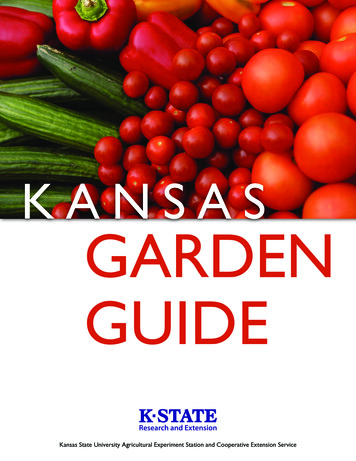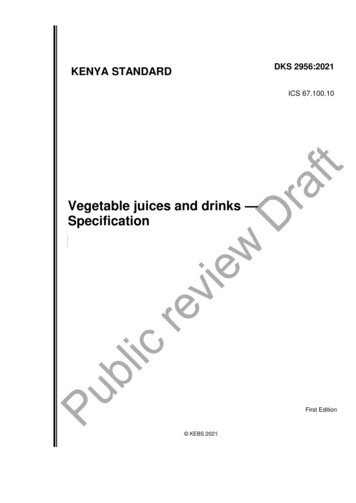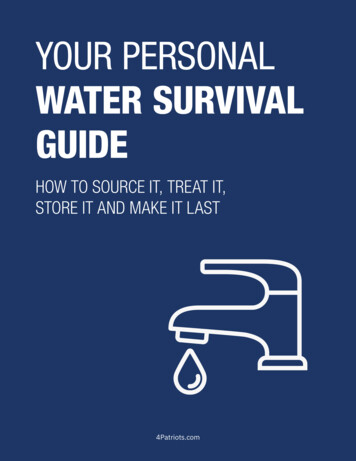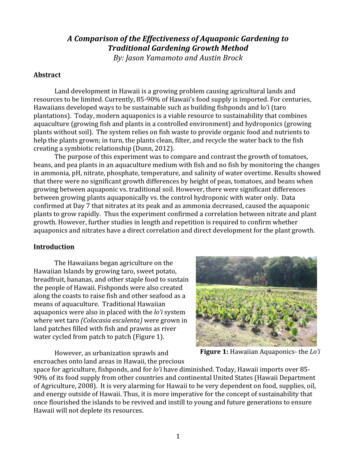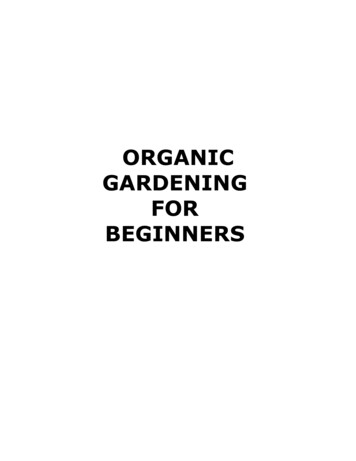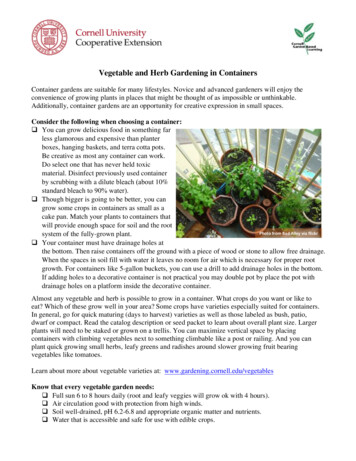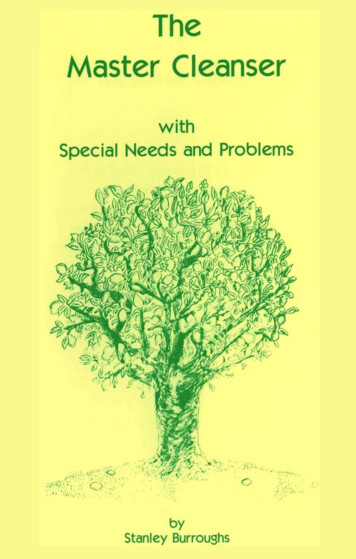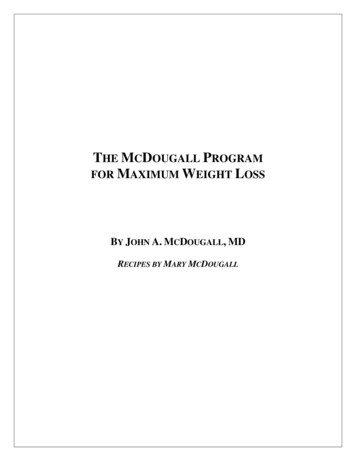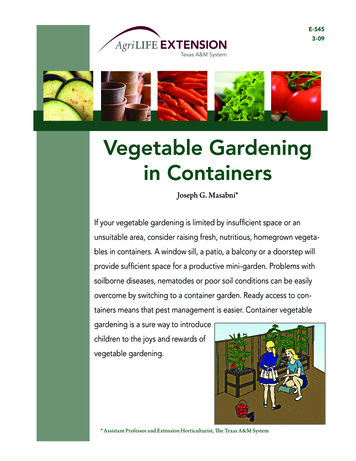
Transcription
E-5453-09Vegetable Gardeningin ContainersJoseph G. Masabni*If your vegetable gardening is limited by insufficient space or anunsuitable area, consider raising fresh, nutritious, homegrown vegetables in containers. A window sill, a patio, a balcony or a doorstep willprovide sufficient space for a productive mini-garden. Problems withsoilborne diseases, nematodes or poor soil conditions can be easilyovercome by switching to a container garden. Ready access to containers means that pest management is easier. Container vegetablegardening is a sure way to introducechildren to the joys and rewards ofvegetable gardening.* Assistant Professor and Extension Horticulturist, The Texas A&M System
Crop SelectionAlmost any vegetable that will grow in a typical backyard garden will also do well as acontainer-grown plant. Vegetables that are ideally suited for growing in containers includetomatoes, peppers, eggplant, green onions, beans, lettuce, squash, radishes and parsley.Pole beans and cucumbers also do well in this type of garden, but they do require considerably more space because of their vining growth habit.Variety selection is extremely important. Most varieties that will do well when planted in ayard garden will also do well in containers. Some varieties of selected vegetables which areideally suited for these mini-gardens are indicated in Table 1.Small fruited tomatovarieties make excellenthanging baskets.Table 1. Varieties for Container Grown Vegetables2Broccoli (2 gallons, 1 plant)Packman, Bonanza, othersCarrot (1 gallon, 2-3 plants. Use pots 2 inchdeeper than the carrot length)Scarlet Nantes, Gold Nugget, Little Finger, Baby Spike,ThumbelinaCucumber (1 gallon, 1 plant)Burpless, Liberty, Early Pik, Crispy, SaltyEggplant (5 gallons, 1 plant)Florida Market, Black Beauty, Long TomGreen Bean (2 gallons minimum, space plants3 inches apart)Topcrop, Greencrop, Contender, (Pole) Blue Lake, KentuckyWonderGreen Onion (1gallon, 3-5 plants)Beltsville Bunching, Crysal Wax, Evergreen BunchingLeaf Lettuce (1 gallon, 2 plants)Buttercrunch, Salad Bowl, Romaine, Dark Green Boston,Ruby, BibbParsley (1gallon, 3 plants)Evergreen, Moss CurledPepper (5 gallons, 1-2 plants)Yolo Wonder, Keystone Resistant Giant, Canape, Red Cherry(Hot), JalapenoRadish (1gallon, 3 plants)Cherry Belle, Scarlet Globe, (White) IcicleSpinach (1 gallon, 2 plants)Any cultivarSquash (5 gallons, 1 plant)Dixie, Gold Neck, Early Prolific Straightneck, Zucco (Green),Diplomat, SenatorTomato (5 gallons, 1 plant)Patio, Pixie, Tiny Tim, Saladette, Toy Boy, Spring Giant,Tumbling Tom, Small FryTurnip (2 gallons, 2 plants)Any cultivar
Growing MediaAny growing media must provide water, nutrients, and a physical support in order to grow healthy plants. A goodgrowing media must also drain well. Synthetic or soilless mixes are well suited for vegetable container gardening andmay be composed of sawdust, wood chips, peat moss, perlite, or vermiculite. These are free of disease and weed seeds,hold moisture and nutrients but drain well and are lightweight. Many synthetic soil mixes such as Jiffy Mix , Bacto ,Promix , and Jiffy Pro are available at garden centers. Soilless mixes can also be prepared by mixing horticulturalgrade vermiculite, peat moss, limestone, superphosphate and garden fertilizer. To 1 bushel each of vermiculite andpeat moss, add 10 tablespoons of limestone, 5 tablespoons of 0-20-0 (superphosphate) and 1 cup of garden fertilizer such as 6-12-12 or 5-10-10. Mix the material thoroughly while adding a little water to reduce dust. Wet the mixthoroughly before seeding or transplanting. Soil mixes are made up of equal parts of sphagnum peat moss or compost,pasteurized soil, and vermiculite or perlite. Composted cow manure is then added to improve the soil’s physical properties and as a nutrient source. Soil mixes tend to hold water better than soilless mixes.ContainersAlmost any type of container can be used for growing vegetableplants. For example, try using bushel baskets, drums, gallon cans, tubsor wooden boxes. The size of the container will vary according to thecrop selection and space available. Pots from 6 to 10 inches in size aresatisfactory for green onion, parsley and herbs. For most vegetablecrops such as tomatoes, peppers and eggplant, you will find that 5 gallon containers are the most suitable size, while 1 to 2 gallon containers are best for chard and dwarf tomatoes. Smaller container sizes areappropriate for herbs, lettuce, and radish crops. They are fairly easy tohandle and provide adequate space for root growth.Container materials are either porous or nonporous. Glazed, plastic,metal, and glass containers are nonporous. Regardless of the type orsize of container used it must drain adequately for successful yields.Adding about 1 inch of coarse gravel in the bottom of the container will improve drainage. The drain holes work bestwhen they are located along the side of the container, about ¼ to ½ inch from the bottom.Any well-drained container can becomea productive mini-garden.Seeding and TransplantingVegetables that can be easily transplanted are best suited forcontainer culture. Transplants may be purchased from localnurseries or can be grown at home. Seeds can also be germinated in a baking pan, plastic tray, pot, or even a cardboard milkcarton. Fill the container with the media described above andcover most vegetable seed with ¼ inch to ½ inch of media toinsure good germination. Another method is to use peat pelletsor peat pots which are available from nursery supply centers.Landscape cloth or screen in the bottom of the pot will improveGreen onions, radishes or beets can be growndrainage and invigorate plant growth.in a cake pan.3
Covering the seed flat with a clearplastic bag will hasten germination.A “tube” or bag garden is an easymethod to grow vegetables.The seed should be started in a warm area that receives sufficient sunlight about 4 to 8 weeks before you plan to transplant them into the final container. Most vegetables should be transplanted into containers when they develop theirfirst two to three true leaves. Transplant the seedlings carefully to avoid injuring the young root system. (See Table 2for information about different kinds of vegetables.)Table 2. Planting Information for Growing Vegetables in ContainersNumber of daysfor germinationNumber ofweeks tooptimum age fortransplantingGeneral sizeof containerAmount of light*requiredNumber of daysfrom seeding geSun50-70Eggplant8-126-8LargeSun90-120Lettuce, leaf6-83-4MediumPartial Shade45-60Onions6-86-8SmallPartial Shade80-100Parsley10-12-SmallPartial allPartial rgeSun90-130Crop*All vegetables grow best in full sunlight, but those indicated will also do well in partial shade.FertilizationAvailable fertilizers will be either time-release or water soluble. Time-release fertilizer is mixed with the potting mediaat planting time. Osmocote is a pelleted time-release fertilizer with 14-14-14 formulation. Water soluble fertilizers, onthe other hand, are added to water and used when plants begin to grow actively. Peters 20-20-20 or Miracle Gro 1530-15 are two examples sold in most garden centers.The easiest way to add fertilizer to plants growing in containers is to prepare a nutrient solution and then pour it overthe soil mix. There are many good commercial fertilizer mixes available to make nutrient solutions. Always follow theapplication directions on the label. You can make a nutrient solution by dissolving 2 cups of a complete fertilizer suchas 10-20-10, 12-24-12, or 8-16-8 in 1 gallon of warm tap water. This mixture is highly concentrated and must be di4
luted before it can be used to fertilize the plants. To make the final fertilizing solution,mix 2 tablespoons of the concentrated solution in 1 gallon of water.If you use transplants, begin watering with the nutrient solution the day you set themout. If you start with seed, apply only tap water to keep the soil mix moist enoughuntil the seeds germinate. Once the plants emerge, begin using the nutrient solution.While the frequency of watering will vary from one crop to the next, usually once perday is adequate. If the vegetable produces a lot of foliage, twice a day may be necessary. Plants require less water during periods of slow growth.At least once a week, it is advisable to leach the unused fertilizer out of the soil mixby watering with tap water. Add enough water to the container to cause free drainagefrom the bottom. This practice will flush harmful minerals out of the the soil mix.It is a good idea to occasionally water with a nutrient solution containing minor elements. Use a water-soluble fertilizer that contains iron, zinc, boron and manganeseand follow the label directions carefully.WateringProper watering is essential for a successful containergarden and one watering per day is usually adequate.However, poor drainage will slowly kill the plants. Ifthe mix becomes water-logged, the plants will die from lack of oxygen. Avoid wettingthe foliage of plants since wet leaves will encourage plant diseases. Remember to usethe nutrient solution for each watering except for the weekly leaching when you willuse tap water.A potato bag is a uniqueway to grow potatoes.Water-holding gels are becoming popular for use in container gardening. These starchbased gels are called hydrogels. They absorb at least 100 times their weight in waterand slowly release that water into the soil as it dries. To be effective, they should beincorporated in the soil mix before planting.Mulches can also be placed on top of the soil mix to reduce water loss. Compost, straw,pine needles, grass clippings, shredded bark, and moss are examples of mulches andvary in their effectiveness.LightNearly all vegetable plants will grow better in full sunlight than in shade. However,leafy crops such as lettuce, cabbage, greens, spinach and parsley can tolerate moreshade than root crops such as radishes, beets, turnips and onions. Fruit bearingplants, such as cucumbers, peppers, tomatoes and eggplant need the most sun of all.One major advantage to gardening in containers is that you can place the vegetablesin areas where they can receive the best possible growing conditions.“Cages” can be used withcontainers to supporttomatoes, cucumbers andpole beans.HarvestingHarvest the vegetables at their peak of maturity when a vegetable’s full flavor has developed. Vine-ripened tomatoes,tender green beans and crisp lettuce will have the best flavor.At the end of the harvest season, discard the plant and soil from the pot. Do not reuse the same soil for a second seasonof production. Infected soil or mix will spread disease into the second season unless it is properly composted. Properlycomposted planting media can be reused.5
Diseases and InsectsVegetables grown in containers are susceptible to the same insects and diseases that are common to any vegetablegarden. You should check your plants periodically for diseases and for foliage and fruit-feeding insects. If you detectplant disease or harmful insects, use EPA-approved fungicides and insecticides in a timely manner. Contact your localcounty Extension agent for the latest information on disease and insect control on vegetable plants.Table 3. Common Problems in Container GardeningSymptomCauseCorrective MeasureInsufficient lightMove container to area receiving more lightExcessive nitrogenReduce feeding intervalsExcessive waterReduce watering intervals; Check for good drainageLow fertilityIncrease fertility level of base solutionPlants wilt although sufficientwater presentPoor drainage andaerationUse mix containing higher percent organic matter; increasenumber of holes for drainageMarginal burning or firing ofthe leavesHigh saltsLeach container with tap water at regular intervalsLow temperatureRelocate container to warmer areaLow phosphateIncrease phosphate level in base solutionHoles in leaves, leavesdistorted in shapeInsectsUse EPA-recommended insecticidePlant leaves with spots; deaddried areas, or powdery or rustyareasPlant diseasesRemove diseased areas where observed and use EPA-recommendedfungicidePlants tall, spindly, andunproductivePlants yellowing from bottom,lack vigor, poor colorPlants stunted in growth;sickly, purplish colorContainer Gardening SuccessContainer gardening can be successful if you follow guidelines above. Plant growth and vigor will vary dependingon the location and attention you give your plants. The following guidelines are golden rules for any home vegetablegarden:1. Inspect your plants daily and, if necessary, water, trim, train or pruning.2. Check your plants daily and remove of pests and weeds and treat diseases.3. Continue your education by soliciting advice from experienced gardeners.4. Make time to sit down and enjoy the fruits of your labor.6
This publication was revised from earlier versions authored by Sam Cotner, Professor andExtension Horticulturist Emeritus, Texas AgriLife Extension, The Texas A&M System.Produced by AgriLife Communications, The Texas A&M SystemExtension publications can be found on the Web at: http://AgriLifeBookstore.org.Visit Texas AgriLife Extension Service at http://AgriLifeExtension.tamu.edu.Educational programs of the Texas AgriLife Extension Service are open to all people without regard to race, color, sex,disability, religion, age, or national origin.Issued in furtherance of Cooperative Extension Work in Agriculture and Home Economics, Acts of Congress of May 8,1914, as amended, and June 30, 1914, in cooperation with the United States Department of Agriculture. Edward G. Smith,Director, Texas AgriLife Extension Service, The Texas A&M System.
overcome by switching to a container garden. Ready access to con-tainers means that pest management is easier. Container vegetable gardening is a sure way to introduce children to the joys and rewards of vegetable gardening. E-545 3-09 * Assistant Professor and Extension Horticulturist, The Texas A&M System

